Cannabis growing FAQ
Managing Excessive Temperatures When Growing Cannabis: Tips and Techniques
Published
7 months agoon
By
admin
Introduction
Growing cannabis can be a rewarding experience, but it also comes with its share of challenges, especially when it comes to managing temperature extremes. Whether you’re facing scorching outdoor temperatures or dealing with heat buildup in your grow room, understanding how to protect your cannabis plants from excessive heat is crucial. As an experienced cannabis grower working with Amsterdam Marijuana Seeds, I’ve encountered and overcome various temperature-related obstacles. In this comprehensive guide, I’ll provide you with valuable insights on managing excessive temperatures and ensuring the health and vitality of your cannabis crops.

Is Too Much Sun Bad for Cannabis?
While cannabis plants love sunlight, excessive exposure to the intense sun can be detrimental. High temperatures and intense light can lead to heat stress and light burn, causing damage to the plant’s leaves and overall growth. To prevent this, consider providing partial shade during the hottest parts of the day or using light diffusing materials to protect your plants from excessive sun exposure.
How Hot is Too Hot for Cannabis?
Cannabis plants have a preferred temperature range of 70°F to 85°F (21°C to 29°C). When temperatures exceed this range, the risk of heat stress and potential damage to your plants significantly increases. Keep a close eye on the thermometer and intervene promptly if temperatures start to soar beyond the ideal range.
What Does an Overheated Cannabis Plant Look Like?
An overheated cannabis plant displays several distinctive signs. The leaves may appear droopy, wilted, or curled, and their edges may turn yellow or brown. Overheating can also cause stunted growth and give the plant an overall stressed and unhealthy appearance.
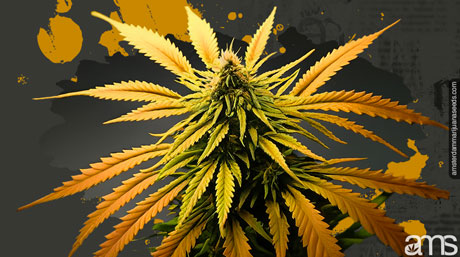
Does Heat Hurt Cannabis?
Yes, excessive heat can hurt cannabis plants. High temperatures can disrupt the plant’s metabolic processes, reduce nutrient uptake, and lead to wilting and leaf burn. If not addressed promptly, prolonged exposure to high heat can severely impact plant health and overall yield.
What Does Light Burn Look Like on Cannabis?
Light burn, also known as light stress, occurs when cannabis plants are exposed to intense light, particularly from high-powered artificial lighting systems. The affected leaves may show bleached or yellow areas, and the tips may appear burnt. Adjusting the light distance and intensity can prevent light burn.
What Are the Symptoms of High Temperature on Plants?
High temperatures can manifest in various ways, including wilting, drooping, leaf discoloration, and overall growth stunting. If the plant’s environment becomes excessively hot, its ability to take in nutrients and water may also be compromised.
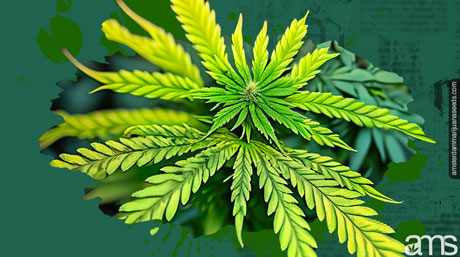
How Do You Tell if a Plant is Burned?
A burned plant will have visible signs of damage on its leaves, such as brown or yellow patches. The tips of the leaves may also appear burnt or crispy. Adjusting the growing conditions and providing appropriate care can aid the plant in recovering from burns.
| Visible Signs of Damage | Description |
|---|---|
| Brown or Yellow Patches on Leaves | Leaves show visible spots of brown or yellow discoloration. |
| Burnt or Crispy Leaf Tips | The tips of the leaves appear burnt or crispy. |
| Recovery Measures | Adjust growing conditions and provide appropriate care to aid the plant’s recovery from burns. |
Can a Plant Recover from Heat Stress?
Cannabis plants are resilient and can recover from heat stress if the issue is addressed promptly. Moving the plant to a cooler location, providing adequate hydration, and optimizing environmental conditions can help the plant bounce back from heat stress.
How Do You Save a Plant That Got Too Hot?
To save a plant that has experienced extreme heat, act swiftly and implement the following steps:
Move the plant to a cooler location with sufficient shade.
Ensure the plant is adequately watered, as heat stress can lead to dehydration.
Create a conducive environment by reducing temperatures and providing good airflow.
Monitor the plant closely for signs of improvement or further stress.
How Do Plants Keep Cool?
Plants employ various mechanisms to stay cool and regulate their internal temperature:
Transpiration: The process by which plants release water vapor through their stomata helps cool the plant.
Leaf Orientation: Some plants orient their leaves to reduce direct exposure to intense sunlight, minimizing heat absorption.
Root Systems: An efficient root system allows plants to draw water from deeper soil layers, mitigating the effects of heat stress.
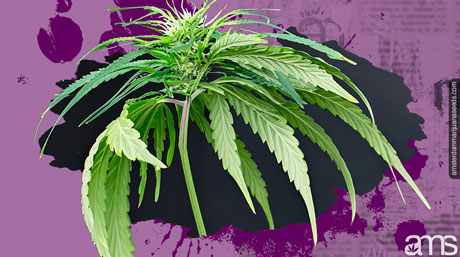
What are Four Ways to Prevent Heat Stress in Plants?
To prevent heat stress in cannabis plants, consider the following strategies:
Shade and Ventilation: Utilize shade cloth or other materials to protect plants from excessive sunlight during peak hours. Additionally, ensure proper ventilation to dissipate excess heat.
Watering Schedule: Maintain a consistent watering schedule, especially during hot weather, to keep the plants hydrated and healthy.
Mulching: Apply organic mulch around the base of plants to help retain soil moisture and regulate temperature.
Choosing Suitable Strains: Opt for cannabis strains that are more tolerant of higher temperatures, especially if you’re cultivating outdoors in a hot climate.
How Do Plants Protect Themselves from Heat?
Plants have evolved several defense mechanisms to protect themselves from heat stress:
Heat Shock Proteins (HSPs): These proteins are produced in response to stress and help the plant recover and maintain cellular integrity.
Antioxidants: Plants produce antioxidants to neutralize harmful free radicals generated during high-temperature stress.
Closing Stomata: In response to heat, plants may close their stomata to reduce water loss through transpiration.
How Do You Control Plant Temperature?
Controlling plant temperature involves careful management of the growing environment. Here are some effective ways to do so:
Use Temperature-Controlled Growing Spaces: In indoor settings, invest in equipment such as air conditioners, fans, and heaters to maintain optimal temperatures.
Shading and Ventilation: In outdoor settings, use shading materials and ensure adequate ventilation to regulate temperature.
Water Management: Proper watering practices can help moderate temperature fluctuations in the soil and improve overall plant health.

What Does Heat Stress Do to Buds?
Heat stress during the flowering phase can significantly impact bud development and quality. It may lead to foxtailing, a condition where the buds produce elongated, spiky calyxes, reducing overall bud density and potency.
How Hot is Too Hot for Flowering?
During the flowering phase, temperatures above 85°F (29°C) can adversely affect bud formation and potency. It’s essential to maintain moderate temperatures during this crucial stage to achieve optimal yields and high-quality buds.
Conclusion
As a cannabis grower, understanding how to manage excessive temperatures is essential for maintaining healthy, thriving plants. Whether you’re growing indoors or outdoors, implementing the right cooling strategies and prevention techniques will help you overcome heat-related challenges and achieve successful cannabis cultivation. By closely monitoring your plants, providing appropriate care, and optimizing the growing environment, you can ensure your cannabis crop thrives even in the face of extreme temperatures.
Frequently Asked Questions
Yes, air conditioners are an effective way to regulate temperature in indoor grow rooms, providing a comfortable environment for your cannabis plants.
It’s best to mist your plants early in the morning or late in the evening to avoid moisture-related issues during the hotter parts of the day.
Cannabis thrives in temperatures between 70°F to 85°F (21°C to 29°C) during the day and slightly cooler temperatures at night.
Yes, heat stress during the flowering phase can impact bud development, potentially leading to reduced potency and altered cannabinoid profiles.
You may like
-


Does Lizzo Consume Weed – The Fresh Toast
-


Do Delta 8 Edibles Work For Female Arousal?
-


Could You Help Your Lips With CBD Balm
-


California Awards $12 Million In Local Cannabis Equity Grants To Repair Drug War Harms
-


Patient Zero for Untreatable Depression Begins Groundbreaking Psychedelics Therapy
-


Mother’s Day weed gift guide 2024
Cannabis growing FAQ
Hash vs. Weed: A Comprehensive Comparison
Published
2 months agoon
March 7, 2024By
admin
By: Juan Sebastian Chaves Gil
In the world of cannabis, the choice between hash and weed has been a constant subject of debate among consumers, experts, and legislators. Both forms of cannabis have their own distinctive characteristics, effects, and methods of consumption, leading to the question: which is better?
Origins and Production Processes:
Hash, also known as hashish, is produced by separating and collecting trichomes, the resin glands of the cannabis plant. These trichomes are pressed to form blocks or converted into powder, resulting in a highly concentrated product. On the other hand, weed, also called marijuana, consists of the dried and cured flowers of the cannabis plant.
Potency and Concentration:
One of the highlights of hashish is its higher concentration of cannabinoids compared to weed. The production process of hashish allows for a more efficient extraction of the active compounds, with a THC content of around 40%, resulting in a more potent experience for the user. However, this higher potency also carries the risk of excessive consumption, which can lead to unwanted effects.
Cannabis, on the other hand, generally contains lower levels of cannabinoids than hashish, with a bud containing between 10% and 20% THC. This can provide a softer, more controlled experience for those who wish to avoid the intense effects associated with hashish.
Variety of Flavors and Aromas:
Weed is characterised by its wide variety of strains, each with a unique flavour and aroma profile. Consumers of weed can enjoy a wide range of sensory experiences, from citrus and earthy notes to sweeter or spicier flavours. Hash, on the other hand, tends to have a more robust and earthy flavour, as it is composed primarily of trichomes, which contain the plant’s aromatic compounds.
Methods of Consumption:
Both forms of cannabis offer various options for consumption. Weed can be smoked in joints, pipes, vaporizers, or even consumed in edibles. Hash, although often smoked, can also be inhaled using specialized vaporizers or mixed with tobacco.
Edibles for a Delicious High
Hash, similar to marijuana, can also be used for medical purposes to alleviate ailments such as nausea, lack of appetite, stress, and fatigue. Hash oil can also be used for patients that have problems with their breathing and don’t want to smoke it, and just like marijuana, hash can also be turned into edibles for a delicious high.
Since one is used to create the other, it only makes sense that marijuana and hash are going to share a lot of similarities. But once the production process has begun and marijuana has started being turned into hash, there are more differences than similarities between the two. And the one that users will find most noticeable is that hash is much more potent and therefore, results in a much more intense high.
Legal and Social Considerations:
Laws and social perceptions regarding cannabis consumption vary significantly worldwide. While some places have legalized or decriminalized the recreational or medicinal use of weed, hash often faces greater stigmatization and legal restrictions.
The choice between hash and weed largely depends on individual preferences, tolerance, and consumer goals. Weed offers a variety of flavors and a less intense experience, while hash provides a concentrated potency appreciated by those seeking a stronger effect. Ultimately, the best choice is subjective and should take into account personal, legal, and social factors.
Cannabis growing FAQ
Grow Bags for Growing Cannabis | The Complete Guide
Published
4 months agoon
January 4, 2024By
admin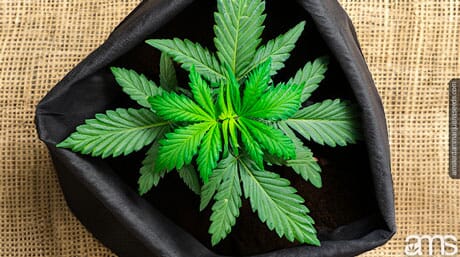
Introduction
Welcome to the ultimate guide on using grow bags for growing cannabis. Whether you’re a seasoned gardener or a cannabis enthusiast looking to cultivate your favorite strain, grow bags offer a versatile and efficient way to nurture healthy cannabis plants. In this article, we’ll answer the most frequently asked questions about grow bags for cannabis cultivation and provide valuable insights into their advantages, disadvantages, and optimal usage. Let’s dive in!
Are Grow Bags Better Than Buckets?
Grow bags have become increasingly popular among cannabis growers due to their numerous benefits. Unlike traditional buckets, grow bags offer superior aeration, root pruning, and drainage, creating a healthier environment for cannabis plants. The porous fabric of grow bags allows excess water to escape, preventing overwatering and root rot, which is a common issue with buckets. Additionally, grow bags are space-efficient and easy to store, making them a practical choice for indoor and outdoor cultivation.
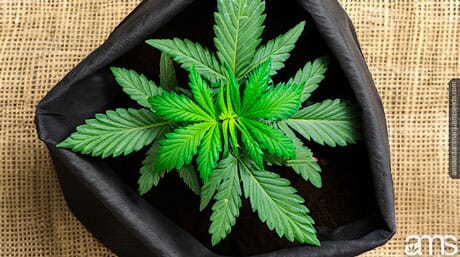
The Pros and Cons of Growing Bags
Like any gardening method, grow bags have their advantages and disadvantages. Let’s explore them in detail:
Pros:
- Aeration: Grow bags promote better air circulation, preventing root circling and promoting healthier root systems.
- Drainage: The breathable fabric ensures proper drainage, reducing the risk of overwatering.
- Prevents Overheating: Grow bags release excess heat, keeping the root zone cooler during hot weather.
- Space-Efficient: They can be easily arranged in tight spaces, maximizing planting area.
- Reusable: Quality grow bags can be washed and reused for multiple growing seasons.
Cons:
- Susceptibility to Drying: Grow bags may dry out more quickly than containers, necessitating more frequent watering in certain environments.
- Durability: Lower-quality grow bags may tear or degrade over time.
- Stability: The soft-sided nature of grow bags can be less stable than rigid containers.
What Size Grow Bag is Best for Indoor Cannabis?
The ideal size of a grow bag for indoor cannabis depends on the space available and the desired plant size. For most indoor growers, a 5-gallon grow bag is a popular choice. This size provides ample space for the roots to spread and promotes healthy growth without taking up excessive room. However, if you have limited space, consider using 3-gallon grow bags for smaller cannabis plants.
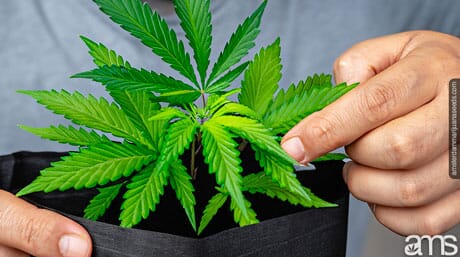
Do Bigger Grow Bags Mean Bigger Buds?
While the size of grow bags can influence plant growth, it’s essential to understand that bigger bags alone won’t guarantee bigger buds. The health and yield of cannabis plants depend on various factors, including light, nutrients, genetics, and environmental conditions. Adequate lighting, proper nutrition, and careful cultivation techniques play a more significant role in bud development.
Is Grow Bags Better for Roots?
Yes, grow bags are generally better for root health compared to traditional containers. The fabric material of grow bags allows air to reach the root zone, encouraging air pruning. When roots reach the fabric’s edge, they encounter air, causing the tips to desiccate and branching to occur. This process prevents root circling, promotes a more extensive root system, and enhances nutrient uptake.
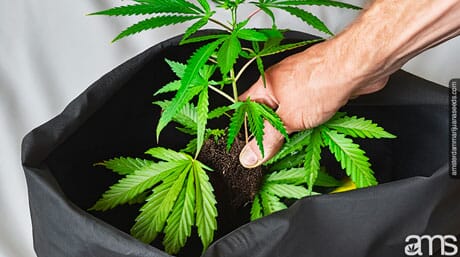
The Disadvantages of Using Grow Bags
While grow bags offer several advantages, it’s crucial to be aware of potential drawbacks:
- Frequent Watering: Grow bags may require more frequent watering compared to conventional containers due to their superior drainage and aeration.
- Durability: Lower-quality grow bags may tear or degrade over time, especially if reused for multiple seasons.
- Stability: Soft-sided grow bags may be less stable than rigid containers, requiring additional support in windy conditions.
Are Grow Bags Better Than Compost?
Grow bags and compost serve different purposes in cannabis cultivation. Grow bags are containers made of breathable fabric that promote healthier root systems through improved aeration and drainage. Compost, on the other hand, is a nutrient-rich organic material that enhances soil quality and fertility. While grow bags provide a conducive environment for roots, compost enriches the soil and provides essential nutrients for plant growth. When used together, grow bags and compost can complement each other, resulting in optimal cannabis growth.
Should I Use Potting Soil in Grow Bags?
Using high-quality potting soil is recommended when cultivating cannabis in grow bags. Look for well-balanced potting mixes that include a blend of peat moss, vermiculite, and perlite. These components provide essential nutrients, promote proper drainage, and offer the right level of aeration for healthy root development. Avoid using garden soil in grow bags, as it may lack the necessary properties and lead to poor plant growth.
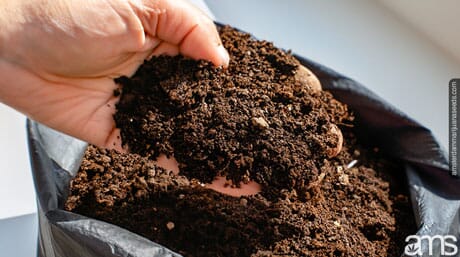
Are Grow Bags Better Than Plastic?
Grow bags and plastic containers cater to different gardening needs. While plastic containers are durable and stable, they lack the superior drainage and aeration of grow bags. The non-porous nature of plastic can lead to overwatering and root issues. Grow bags, with their breathable fabric, offer improved air circulation and prevent waterlogged roots. However, both options have their benefits and can be used successfully for cannabis cultivation based on personal preferences and growing conditions.
How Long Can a Grow Bag Last?
The lifespan of a grow bag varies depending on its quality and usage. High-quality grow bags made from sturdy fabric can last for several growing seasons if properly cared for and stored during the off-season. Regularly clean the grow bags after each use, allow them to dry completely, and store them in a cool, dry place to extend their lifespan.
Should I Put Holes in My Grow Bag?
Grow bags are designed with pre-made drainage holes to allow excess water to escape, preventing overwatering. However, in certain cases, additional holes may be necessary to ensure proper drainage, especially if you notice water pooling at the bottom of the bag. Use a sharp object to make small drainage holes at the bottom, ensuring they do not compromise the structural integrity of the bag.

Should I Put Rocks in the Bottom of My Grow Bag?
Adding rocks or stones at the bottom of grow bags is unnecessary and may lead to drainage issues. The practice was once believed to improve drainage, but it can create a false water table, leading to waterlogged soil at the root level. For optimal results, rely on the natural drainage provided by the grow bag’s fabric and ensure the bag has adequate drainage holes.
Do Grow Bags Get Too Hot?
Grow bags are designed to release excess heat, preventing the root zone from getting too hot. The breathable fabric allows air to circulate around the root system, maintaining a more stable temperature. However, in extremely hot climates, grow bags can still get warm. To mitigate this, place the grow bags in a shaded area or use mulch to insulate the root zone and retain moisture.
Do Grow Bags Need Perlite?
While perlite can enhance the drainage and aeration of potting soil, it is not essential for grow bags. Grow bags already provide excellent aeration and drainage due to their fabric material. However, if you prefer a looser soil mix, you can add perlite to your potting soil before filling the grow bags.
When Should You Stop Using a Grow Bag?
Grow bags are reusable and can last for multiple growing seasons. However, over time, the fabric may become worn or damaged. Consider replacing the grow bags if you notice significant tears or degradation that may compromise the root zone’s health. Regularly inspect the grow bags after each growing season to assess their condition.

What Can I Use Instead of Grow Bags?
If grow bags are not available, several alternative containers can be used for cannabis cultivation, including:
- Plastic Nursery Pots: Similar to grow bags but made of plastic, these pots provide good drainage.
- Fabric Pots: Fabric containers with properties similar to grow bags, promoting aeration and root pruning.
- Five-Gallon Buckets: While not as efficient as grow bags, buckets can still be used for cannabis cultivation with proper drainage and aeration.
Can You Use Grow Bags Twice?
Yes, grow bags can be reused for multiple growing seasons with proper care and maintenance. After each growing season, clean the grow bags thoroughly, allow them to dry completely, and store them in a cool, dry location. Inspect the grow bags for any signs of damage or wear before using them again.
What is the Best Size Grow Bag?
The best size grow bag for cannabis depends on several factors, including the available space, plant size, and growing environment. For most indoor growers, 5-gallon grow bags are a popular choice, offering ample room for root growth without taking up excessive space. Outdoor growers may opt for larger sizes, such as 10-gallon grow bags, for larger plants or increased root space.
Do Grow Bags Need Trays?
Grow bags typically do not require trays, as their superior drainage prevents water from pooling at the bottom. However, if you want to protect the surface beneath the grow bags or prefer a neater appearance, you can use trays or saucers.
How Many Plants Can You Put in a Grow Bag?
The number of plants per grow bag depends on the bag’s size and the intended plant size. In a 5-gallon grow bag, one healthy cannabis plant is typically recommended. For smaller cannabis plants or those with shorter growth periods, you may consider growing two plants in a 5-gallon grow bag. However, overcrowding should be avoided, as it can lead to competition for nutrients and space.
Can I Bottom Water in a Grow Bag?
While bottom watering can be done in certain situations, it is not the most efficient method for grow bags. Due to the breathable fabric, water may escape through the bottom, leading to uneven watering and potential overwatering. Instead, opt for top watering, allowing water to evenly disperse throughout the growing medium and promote even root growth.
Conclusion
Grow bags offer a fantastic option for cultivating healthy and thriving cannabis plants. With their excellent drainage, aeration, and root-friendly environment, they can help you achieve successful cannabis cultivation both indoors and outdoors. Consider the advantages and disadvantages of grow bags, select the appropriate size for your needs, and follow best practices to grow vigorous cannabis plants in these versatile containers. Happy gardening!
Frequently Asked Questions
Yes, grow bags are suitable for both indoor and outdoor cannabis cultivation.
Watering frequency varies depending on environmental conditions. Check the soil moisture regularly and water when the top inch feels dry.
Yes, DIY grow bags can be made from breathable fabric and are a cost-effective option.
Ensure proper spacing between plants and provide adequate support for taller cannabis varieties.
Regularly monitor water and nutrient levels, prune as needed, and protect the plants from pests and diseases.
Rinse the grow bags with water, scrub away any debris, and let them air dry before storing.
Cannabis growing FAQ
Grow Exceptional Cannabis on Your Balcony or Terrace
Published
7 months agoon
October 10, 2023By
admin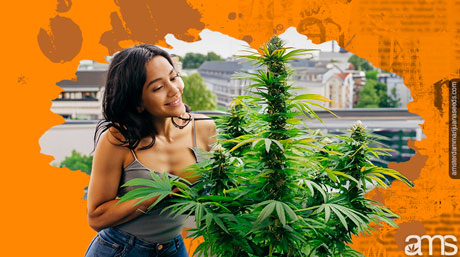
Welcome to our comprehensive guide on growing high-quality cannabis right on your very own balcony or terrace. At Amsterdam Marijuana Seeds, we are passionate about empowering enthusiasts like you to produce exceptional cannabis crops in urban settings. With the right knowledge and techniques, you can achieve impressive yields and top-notch buds, all within the confines of your limited space.
Understanding Your Balcony or Terrace Environment
Before we dive into the cultivation process, it’s essential to assess your specific environment. Factors like sunlight exposure, wind patterns, and available space will influence your growing strategy.
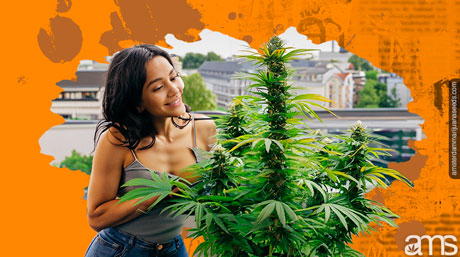
Analyzing Sunlight Exposure
Cannabis thrives in full sun, so it’s crucial to determine how much sunlight your balcony or terrace receives daily. Observe the area at different times of the day to identify any potential shade or obstructions that could hinder sunlight exposure.
Considering Wind Patterns
Strong winds can damage delicate cannabis plants, so it’s vital to consider wind patterns in your location. You may need to set up windbreaks or place your plants strategically to protect them from excessive gusts.
Selecting the Right Cannabis Strain
Growing autoflowering cannabis is an excellent choice for small spaces like balconies or terraces due to its unique characteristics. Here’s why autoflowers are perfect for such settings:
- Compact Size: Autoflowering strains typically grow much smaller than photoperiod cannabis, some reaching only 40–60cm in height. This compact size ensures a discreet grow and reduces the risk of detection.
- Independent Flowering: Unlike photoperiod strains, autoflowers don’t rely on a change in light cycle to initiate and maintain flowering. You have the flexibility to plant and harvest them at any time of the year.
For those looking to cultivate autoflowering strains on a balcony, here are some excellent options:
- Green Crack Autoflower Seeds: Experience an energetic effect and fabulous aroma with this powerful marijuana strain, perfect for an uplifting experience.
- Amnesia Trance Autoflower: Winner of the prestigious Sativa Cup in 2012, our F3 version of Amnesia Trance offers bigger buds, higher yields, and an even more powerful effect, making it a classic choice.
- White Widow XTRM ® Autoflower: Known for its beautiful white buds covered in sticky resin crystals, White Widow XTRM ® provides an extreme high and divine taste, making it a popular white strain.
When it comes to growing cannabis in limited spaces, autoflowering strains are the way to go. Their smaller size, independent flowering, and delightful varieties make them a perfect match for balcony cultivation.
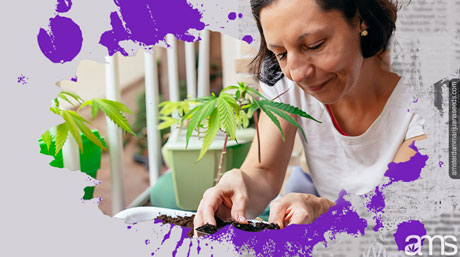
Choosing the Right Cannabis Strain: Key Factors for Successful Cultivation
The success of your cannabis cultivation largely depends on choosing the right strain for your specific environment. Consider the following factors when selecting a strain:
Climate Suitability
Opt for strains that are well-suited to your climate. If you have a warm climate, look for strains that can handle heat without wilting. For cooler climates, choose strains that are more resilient to lower temperatures.
Space Constraints
Since you’ll be growing in a confined space, opt for compact and bushy strains that don’t require excessive vertical growth. Indica-dominant strains are usually a good choice for limited spaces.
Yield Potential
Balcony and terrace growers may want to maximize their yields. Look for strains known for their abundant harvests, so you get the most out of your small growing area.
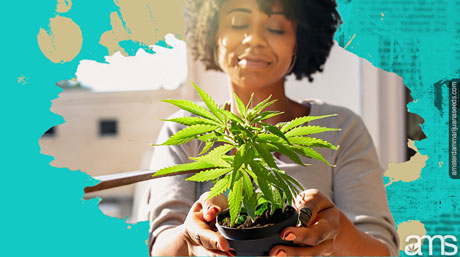
Preparing the Growing Space
Now that you’ve chosen the perfect strain for your balcony or terrace, it’s time to prepare the growing space for your cannabis plants.
Containers and Planters
Select large, sturdy containers or planters with good drainage to accommodate your cannabis plants. Ensure they have enough space for root development and proper aeration.
Quality Soil Mix
Use a high-quality, well-draining soil mix enriched with the right nutrients for cannabis cultivation. Avoid using garden soil, as it may not provide the ideal conditions for your plants.
Adequate Drainage
Proper drainage is essential to prevent waterlogging, which can lead to root rot. Elevate your containers slightly and add a layer of rocks at the bottom to improve drainage.
Nurturing Your Cannabis Plants
Cannabis plants require attentive care throughout their growth cycle. Follow these essential tips to nurture healthy and productive plants:
Watering
Maintain a consistent watering schedule, ensuring the soil remains evenly moist but not waterlogged. Cannabis plants are sensitive to overwatering, so avoid letting them sit in standing water.
Nutrients
Supply your cannabis plants with the necessary nutrients at each stage of growth. You can use organic fertilizers or opt for hydroponic nutrient solutions for a more controlled approach.
Pruning and Training
Regularly prune your plants to encourage bushier growth and remove any dead or damaged foliage. Consider using low-stress training (LST) techniques to optimize light exposure and boost yields.

Protecting Your Cannabis Crop
Growing cannabis outdoors exposes your plants to various potential risks. Protect your crop with these preventive measures:
Pests and Diseases
Inspect your plants regularly for signs of pests or diseases. Implement natural pest control methods like neem oil or introduce beneficial insects to keep harmful pests at bay.
Security and Privacy
Maintain your plants’ security and privacy by using discreet containers and avoiding unnecessary attention. A privacy screen or trellis can also shield your cannabis garden from prying eyes.
Harvesting and Curing Your Cannabis
As harvest time approaches, keep an eye on the trichomes’ color to determine the ideal time for harvesting. Once harvested, follow these steps for proper curing:
- Trim excess leaves and branches from the buds.
- Place the trimmed buds in glass jars, filling them up to about three-quarters full.
- Store the jars in a cool, dark place with controlled humidity.
- Open the jars daily for the first week to release excess moisture, then gradually reduce the frequency.
Conclusion
By following this comprehensive guide, you are now equipped to cultivate outstanding cannabis crops right on your balcony or terrace. Remember, attention to detail, regular care, and a suitable strain choice will greatly contribute to your success. Happy growing!
Frequently Asked Questions
The average outdoor cannabis plant can reach a height of 6 to 12 feet, depending on the strain, growing conditions, and care provided.
For outdoor cannabis cultivation, each plant requires a spacing of at least 4 to 6 feet between them to allow ample sunlight and airflow for optimal growth.
The time required for outdoor cannabis to fully mature depends on the strain and growing conditions. Generally, it takes around 8 to 12 weeks from the germination stage to harvest.
Outdoor cannabis thrives in a sunny, temperate climate with well-draining soil. It prefers temperatures between 70°F to 85°F (21°C to 29°C) during the day and slightly cooler temperatures at night.
Watering frequency for outdoor cannabis depends on various factors like climate, soil, and plant size. As a general guideline, water the plants deeply once or twice a week, ensuring the soil is evenly moist but not waterlogged. Always monitor the soil’s moisture level to avoid overwatering or underwatering.

Does Lizzo Consume Weed – The Fresh Toast

Do Delta 8 Edibles Work For Female Arousal?

Could You Help Your Lips With CBD Balm

California Awards $12 Million In Local Cannabis Equity Grants To Repair Drug War Harms

Patient Zero for Untreatable Depression Begins Groundbreaking Psychedelics Therapy

Mother’s Day weed gift guide 2024

Key Things To Know About Hemp And Marijuana Drinks

Indica, Sativa, Hybrid & More

A Deep Dive into the Benefits of Medical Marijuana for Mental Health

Canada’s medical cannabis exports jump to CA$220 million as domestic sales fall

Distressed Cannabis Business Takeaways – Canna Law Blog™

United States: Alex Malyshev And Melinda Fellner Discuss The Intersection Of Tax And Cannabis In New Video Series – Part VI: Licensing (Video)

Drug Testing for Marijuana – The Joint Blog

What you Need to Know

Cannabis, alcohol firm SNDL loses CA$372.4 million in 2022

NCIA Write About Their Equity Scholarship Program

City Of Oakland Issues RFP For Employee Training Programs

It has been a wild news week – here’s how CBD and weed can help you relax

A new April 20 cannabis contest includes a $40,000 purse

UArizona launches online cannabis compliance online course
Trending
-

 Cannabis News1 year ago
Cannabis News1 year agoDistressed Cannabis Business Takeaways – Canna Law Blog™
-

 One-Hit Wonders1 year ago
One-Hit Wonders1 year agoUnited States: Alex Malyshev And Melinda Fellner Discuss The Intersection Of Tax And Cannabis In New Video Series – Part VI: Licensing (Video)
-

 drug testing5 months ago
drug testing5 months agoDrug Testing for Marijuana – The Joint Blog
-

 Cannabis 1011 year ago
Cannabis 1011 year agoWhat you Need to Know
-

 Marijuana Business Daily1 year ago
Marijuana Business Daily1 year agoCannabis, alcohol firm SNDL loses CA$372.4 million in 2022
-

 Education1 year ago
Education1 year agoNCIA Write About Their Equity Scholarship Program
-

 Education1 year ago
Education1 year agoCity Of Oakland Issues RFP For Employee Training Programs
-

 Cannabis1 year ago
Cannabis1 year agoIt has been a wild news week – here’s how CBD and weed can help you relax



